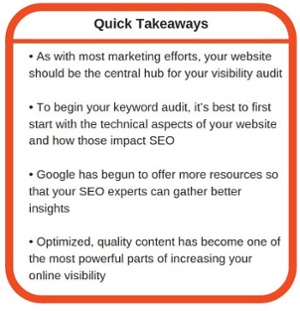 As with any aspect of marketing, you have to check the pulse of your online presence to find both the opportunities and gaps. The first step in improving your online footprint is a visibility audit. This type of audit looks at multiple facets of your digital marketing efforts, focusing on SEO and keywords, online share of voice, and content.
As with any aspect of marketing, you have to check the pulse of your online presence to find both the opportunities and gaps. The first step in improving your online footprint is a visibility audit. This type of audit looks at multiple facets of your digital marketing efforts, focusing on SEO and keywords, online share of voice, and content.
It’s integral to your digital success to regularly conduct a visibility audit. Read on to learn about each part of the audit and how it plays a hand in helping customers, prospects and recruits find you online.

Your Visibility Audit: The Basics
The audit should break down all of your online activity. As with most marketing efforts, your website should be the central hub for your visibility audit. There are many ways to audit a website, some more effective and efficient than others. The tactic that you use should be comprehensive. In the end, what you find should make it possible to identify areas of improvement.
First, start with a keyword audit, which can have multiple parts. Then find your online share of voice, defined as the percentage your brand has of your industry’s total voice. Finally, perform an analysis of your content and how it’s positioning the brand in the market.
SEO Visibility Audit
To begin your keyword audit, it’s best to first start with the technical aspects of your website and how those impact SEO. The back end of your website has a considerable effect on your SEO efforts.
Here are some questions to ask when auditing the back end:
- Is your site “Secure” and does it have an SSL certificate (a certificate that secures and encrypts data), so your web address displays https?
- Does your site render correctly no matter what size of your device?
- Do you have all the right tracking codes from Google Analytics or other platforms?
- Are you using an SEO plug-in to manage metadata like Yoast?
- Is your metadata—titles, descriptions and image tags—complete and optimized?
- Does your site use an XML sitemap (a roadmap of your website that leads Google to all your important pages) to improve your pages’ indexing and crawlability?
On-Page SEO Audit
Next, you’ll need to audit on-page SEO. This is the area where you have the most control when it comes to SEO as most other things are influenced and guided by ISPs. On-page SEO consists of all the factors on your site that impact where you rank in organic search.

Google’s ranking is based on at least 200 different elements, all of which you can’t optimize for. But, you can hit the ones that mean the most. To build your SEO audit framework, there are important questions to consider.
If using a keyword plug-in, how many of your pages have “good” SEO scores versus “okay” or “needs work”? Document the ones that aren’t in good shape, so you can prioritize improvements. The content may be too short or have too high or too low keyword density.
Other audit factors include “trust” factors. How does a search engine or user know your site is legitimate? Do you have relevant information like a business address and phone number? Does the site have other trust indicators such as privacy policy, terms of service, and notice of cookies?
Another aspect of on-page SEO is the way in which you structure content. Are you using header tags (H1, H2, etc.) appropriately? What about interlinking between pages? How about your navigation? Is it easy to find information for the user?
These are only the starter questions for an in-depth on-page SEO audit. One other thing to keep in mind is that on-page SEO audits are never complete. They are ongoing, as the world of keywords is constantly changing.
Off-Page SEO Audit
This part of your visibility audit is challenging for all parties. There are so many factors affecting it, and you don’t have control over many of those. It’s harder but necessary. Luckily, it has gotten somewhat easier to integrate off-page SEO into your audit. Google has begun to offer more resources so that your SEO experts can gather better insights.
One of the major challenges is quantifying backlinks. No matter what tools you use, it’s still rather impossible to have all the data that Google does. There are tools that are worth using for this, especially Ahrefs, or you could use the official option—Google Webmaster Tools.
Off-Page SEO Audit Questions
- What are your referring domains?
- What is the number of backlinks for each page (not just the home page)?
- About how many total referring domains link to your entire website?
- Are your backlinks growing or shrinking—how is this aligned to your backlink strategy?
- How many shares is your site receiving on social media? To improve your shares, you’ll need a strategy for marketing on social media.
- Is your site getting traffic and mentions from social platforms?
- Are your backlinks of a high quality? Quality matters more than quantity, and the quality of your backlinks is measured by the quality of the referring site.
Online Share of Voice Audit
The higher your share of voice, the better for your online presence. Here’s how to audit it:
- Choose your keywords: Decide which ones are most important for your brand – this is typically decided by your services or expertise
- Determine which competitors you’ll compare yourself to
- Find the ranking for each keyword chosen for your brand and your competitors
- Calculations—you’ll need the average CTR to determine this because rank alone isn’t sufficient when comparing sites. For each keyword, add up the CTRs of as many positions as yours and your competitors’ websites received. You can use a standardized percentage of clicks based on position from this study by Optify.
Then, your share of voice is the percentage as noted by the study. So, for position number three, that average CTR is 9.5 percent. If that is where your keyword ranks, that’s your share of voice.
Content and Messaging Audit
The final part of your visibility audit is looking at your content. This involves your content strategy. Optimized, quality content has become one of the most powerful parts of increasing your online visibility. Without regular content added to your site, there won’t be anything to build your presence. Get some tips on creating quality content here.
 Content Audit Questions
Content Audit Questions
To complete the content audit, you need to determine first if your positioning and messaging make sense to your audience. Ask yourself these questions:
- Is your content written with a clear understanding of buyer personas and use cases?
- Does content follow the themes of being helpful, valuable and actionable?
- Do you use words that are meaningful to your audience—what would they search for? What are their questions or pain points?
- Are you using landing pages that showcase specific products or services?
- How long is your content? You’ll need short- (300-500) and long-form (1,000 words or more).
- Does each piece of content correlate with a step in the buyer journey?
- Do all content pages include engaging visuals?
- Do content pages use personalization whenever possible?
Visibility Audits—Not Easy but Necessary
As you can see, visibility audits aren’t easy. They take a lot of time and effort, and it’s not something you just do once. It’s a living document that needs regular checkups to monitor your progress and help you find where you’re winning and where you have room to improve.
Because this is such a huge endeavor that takes a lot of time, you may feel it’s too overwhelming. However, PAN Communications can conduct a visibility audit for your brand, complete with analytics and insights. Get in touch with us today to start the process and discover where you are and where you can go.

 Michael Brenner
Michael Brenner